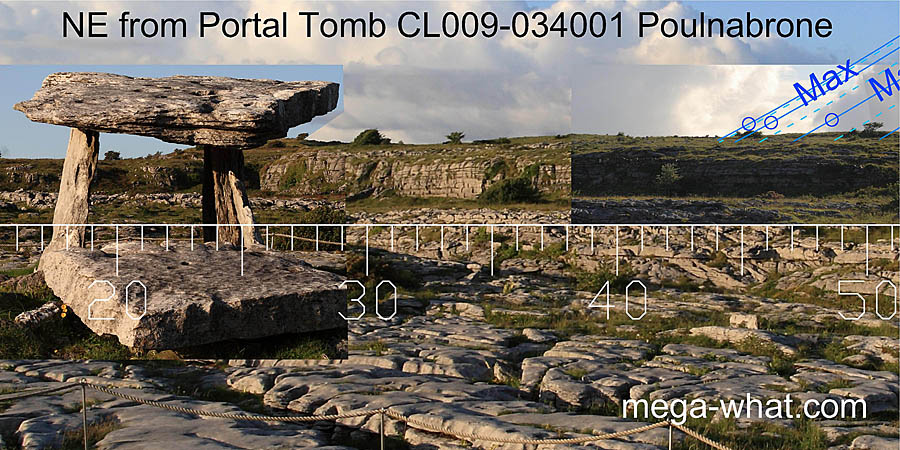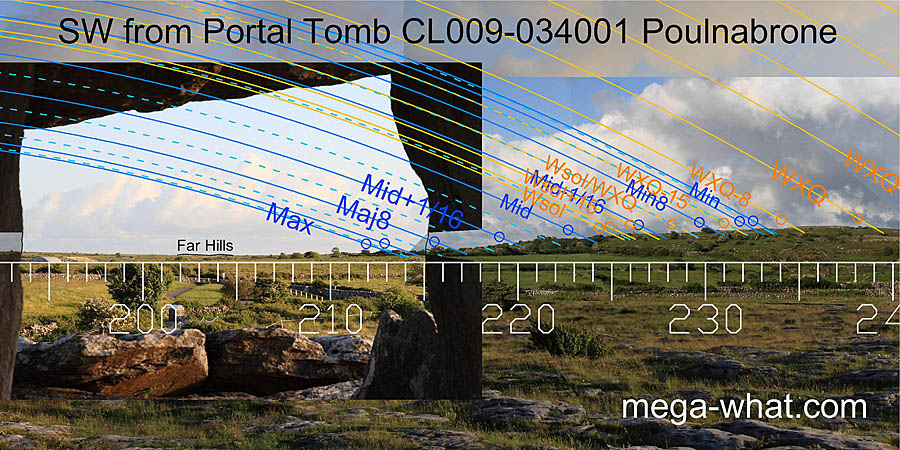 Poulnabrone Portal Tomb is a megalithic tomb of the neolithic period and is a National Monument (no.632) in the guardianship of the state.
Excavated in 1986 (Lynch & Ó Donnabháin, 1994) and 14C dated to c.3800-c.3200 BC by ten bone samples from the chamber.
There was a large quantity of uncremated bone from at least 22 individuals of both sexes and all ages, interred over six centuries.
Commonly known as Poulnabrone Dolmen, this is a very popular megalithic tomb with visitors to the Burren of County Clare.
It looks spectacular, has good parking and is located conveniently close to R480 about 7km south of Ballyvaghan.
Poulnabrone Portal Tomb is a megalithic tomb of the neolithic period and is a National Monument (no.632) in the guardianship of the state.
Excavated in 1986 (Lynch & Ó Donnabháin, 1994) and 14C dated to c.3800-c.3200 BC by ten bone samples from the chamber.
There was a large quantity of uncremated bone from at least 22 individuals of both sexes and all ages, interred over six centuries.
Commonly known as Poulnabrone Dolmen, this is a very popular megalithic tomb with visitors to the Burren of County Clare.
It looks spectacular, has good parking and is located conveniently close to R480 about 7km south of Ballyvaghan.
Other finds from the chamber were: 1 polished stone axe, 2 stone beads, a decorated bone pendant, a fragment of a mushroom-headed bone pin, 2 quartz crystals, several sherds of undiagnostic coarse pottery, 1 hollow-based chert arrowhead, 2 leaf-shaped chert points, 1 chert side-scraper, 1 chert end-scraper, 1 flint end-scraper. Finds from the cairn included small fragments of human and animal bone, a few sherds of coarse pottery similar to that recovered from the chamber, a polished bone point and a possible hammerstone.
 North is marked by a step at the end of a ridge [Pic].
Major standstillLunistice positions vary cyclically over an 18.6 year period but are fairly static for more than a year at either end of the range
moonrise is at a dip in the top and the whole luni-solar sequence runs along the ridge and on down a slope to south
major standstillLunistice positions vary cyclically over an 18.6 year period but are fairly static for more than a year at either end of the range
moonrise at the edge of a wide dip.
South is in the dip but not at the lowest point [Pic]. Major standstillLunistice positions vary cyclically over an 18.6 year period but are fairly static for more than a year at either end of the range
moonset is then at the foot of the next slope and from there everything spans a rise, dip, rise sequence, ending with summer solstice sunset at the foot of a slope and
major standstillLunistice positions vary cyclically over an 18.6 year period but are fairly static for more than a year at either end of the range
moonset in a slight dip.
North is marked by a step at the end of a ridge [Pic].
Major standstillLunistice positions vary cyclically over an 18.6 year period but are fairly static for more than a year at either end of the range
moonrise is at a dip in the top and the whole luni-solar sequence runs along the ridge and on down a slope to south
major standstillLunistice positions vary cyclically over an 18.6 year period but are fairly static for more than a year at either end of the range
moonrise at the edge of a wide dip.
South is in the dip but not at the lowest point [Pic]. Major standstillLunistice positions vary cyclically over an 18.6 year period but are fairly static for more than a year at either end of the range
moonset is then at the foot of the next slope and from there everything spans a rise, dip, rise sequence, ending with summer solstice sunset at the foot of a slope and
major standstillLunistice positions vary cyclically over an 18.6 year period but are fairly static for more than a year at either end of the range
moonset in a slight dip.
 North-eastwards, the tomb axis is towards the north basal step of a ridge and declinations in the mid thirties [Pic].
The south basal step of the ridge is a half-month bracket for the summer cross-quarter and the half-month the other side is at a dip in the ridge.
Undulations on this skyline are slight and the true profile is masked by a stone wall but it is clearly astronomically useful.
Closer to the tomb's axis, a thirtysecondth occurs on a high point and another at the top of a slope.
They bracket the major eighth and lunar eighths correspond with months centred on cross-quarters.
North-eastwards, the tomb axis is towards the north basal step of a ridge and declinations in the mid thirties [Pic].
The south basal step of the ridge is a half-month bracket for the summer cross-quarter and the half-month the other side is at a dip in the ridge.
Undulations on this skyline are slight and the true profile is masked by a stone wall but it is clearly astronomically useful.
Closer to the tomb's axis, a thirtysecondth occurs on a high point and another at the top of a slope.
They bracket the major eighth and lunar eighths correspond with months centred on cross-quarters.
 Further east, the horizon is lower and partially obscured with the equinoctial position being occupied by a house.
Further east, the horizon is lower and partially obscured with the equinoctial position being occupied by a house.
 The south-eastern horizon is a smooth, gentle slope that offers no markers.
Note the pointed boulder. It has (perhaps) been set on the limestone pavement so that it marks the position of most extreme southerly moon rise.
Previously, this boulder, if noticed at all, has most certainly been regarded as a natural erratic but was quite possibly placed there deliberately to form an integral part of the monument.
The stones holding it in place look remarkably like a folding wedge [Pic].
The south-eastern horizon is a smooth, gentle slope that offers no markers.
Note the pointed boulder. It has (perhaps) been set on the limestone pavement so that it marks the position of most extreme southerly moon rise.
Previously, this boulder, if noticed at all, has most certainly been regarded as a natural erratic but was quite possibly placed there deliberately to form an integral part of the monument.
The stones holding it in place look remarkably like a folding wedge [Pic].
Similar use of "erratic" boulders may be seen at Teergonean Court Tomb
 To the south-west, the tomb axis is towards a distant horizon and declinations in the low to mid thirties [Pic].
The critical zone, once more, is a nearby ridge and the lunar major standstillLunistice positions vary cyclically over an 18.6 year period but are fairly static for more than a year at either end of the range
is at the southern base of it, just inside the tomb's axial spread, with the
lunisticeLunistices are the most northerly and southerly moons of the month. The lunar equivalent of solstices - more.
range running up the slope and ending at a notch before the top. A number of key points are recognisable though again the profile is disguised by walls and bushes.
The lunar minor standstillLunistice positions vary cyclically over an 18.6 year period but are fairly static for more than a year at either end of the range
on one side of the hilltop and the cross-quarter on the other is an early use of a technique seen repeatedly.
To the south-west, the tomb axis is towards a distant horizon and declinations in the low to mid thirties [Pic].
The critical zone, once more, is a nearby ridge and the lunar major standstillLunistice positions vary cyclically over an 18.6 year period but are fairly static for more than a year at either end of the range
is at the southern base of it, just inside the tomb's axial spread, with the
lunisticeLunistices are the most northerly and southerly moons of the month. The lunar equivalent of solstices - more.
range running up the slope and ending at a notch before the top. A number of key points are recognisable though again the profile is disguised by walls and bushes.
The lunar minor standstillLunistice positions vary cyclically over an 18.6 year period but are fairly static for more than a year at either end of the range
on one side of the hilltop and the cross-quarter on the other is an early use of a technique seen repeatedly.
 The western end of the ridge top is about a half-month south of the equinox which occurs close to the basal step.
The first top of a more distant ridge is about a half-month north of the equinox and the next top after that is half way to the summer cross-quarter.
The half-month south of the cross-quarter is a diameter south of the terminal top of this distant ridge and then some forestry intervenes.
The western end of the ridge top is about a half-month south of the equinox which occurs close to the basal step.
The first top of a more distant ridge is about a half-month north of the equinox and the next top after that is half way to the summer cross-quarter.
The half-month south of the cross-quarter is a diameter south of the terminal top of this distant ridge and then some forestry intervenes.
 The minor lunar limit is at the basal dip of a long slope which leads up to a hilltop that marks both the lunar midpoint and the half-month bracket for the summer solstice.
This horizon is distant and its undulations small but it was clearly fitted to the lunisticeLunistices are the most northerly and southerly moons of the month. The lunar equivalent of solstices - more.
range as the major standstillLunistice positions vary cyclically over an 18.6 year period but are fairly static for more than a year at either end of the range
occurs at a dip. The intersection of this distant horizon with local ground is almost exactly due north [Pic].
The minor lunar limit is at the basal dip of a long slope which leads up to a hilltop that marks both the lunar midpoint and the half-month bracket for the summer solstice.
This horizon is distant and its undulations small but it was clearly fitted to the lunisticeLunistices are the most northerly and southerly moons of the month. The lunar equivalent of solstices - more.
range as the major standstillLunistice positions vary cyclically over an 18.6 year period but are fairly static for more than a year at either end of the range
occurs at a dip. The intersection of this distant horizon with local ground is almost exactly due north [Pic].
- Leamaneh Court Tomb is c.7km south
- Teergonean Court Tomb is c.17km west-south-west
- Arderrawinny Portal Tomb is in Co. Cork
References
- Archaeological Survey of Ireland, record details. www.archaeology.ie/archaeological-survey-ireland
- DE VALERA, RUAIDHRÍ & Ó'NUALLÁIN, SEÁN 1961 Survey of the Megalithic Tombs of Ireland, Volume I: Co. Clare. Dublin: Stationary Office. p23, no.28.
- LYNCH, A. 1986 Poulnabrone portal tomb. Excavations - Summary accounts of archaeological excavations in Ireland 1986:12. Dublin: Association of Irish Archaeologists.
- LYNCH, A. 1986 Clare 1986:11 Poulnabrone. www.excavations.ie
- LYNCH, A. 1988 Clare 1988:05 'Poulnabrone Portal Tomb', Poulnabrone. www.excavations.ie
- LYNCH, A. 1988 Poulnabrone - A Stone in Time. Archaeology Ireland, Vol.2 No.3: 105-107. Bray:Wordwell.
- LYNCH, A. & Ó DONNABHÁIN, B. 1994 Poulnabrone Portal Tomb. The Other Clare 18: 5-7. Ennis: Shannon Archaeological and Historical Society.
